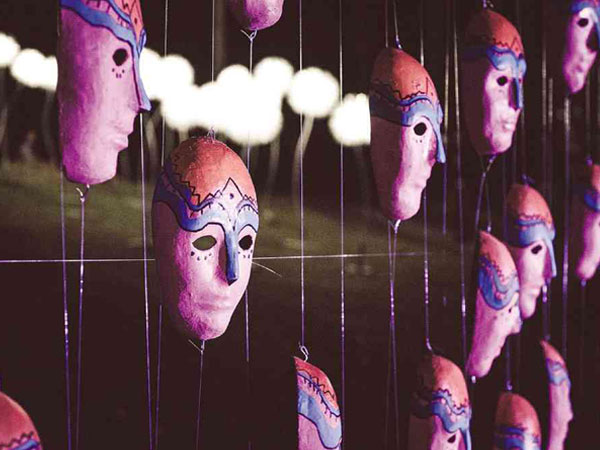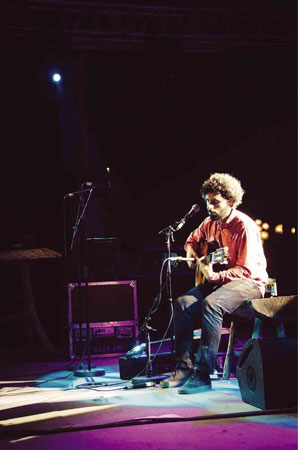Int’l music fest windfall for Mindoro

AN INSTALLATION art titled “Pigeon Hole” by Filipino artist Hiyas Baldemor Bagabaldo at the Malasimbo Festival in Puerto Galera, Oriental Mindoro province, from Feb. 27 to March 3. RENATO VALENZUELA JR. / CONTRIBUTOR
Whether it is to satisfy one’s craving for exquisite music, to embrace nature, or to build actual human connection outside the World Wide Web, people across continents must have their reasons to spend time and money traveling down south to this small island community for the Malasimbo Festival.
But to Aries Quinto, a 26-year-old driver of a public utility van here, the days of the international festival mean the best time to earn a living.
“It’s when the most number of tourists comes. Most of them are foreigners, too,” Quinto said as he drove this van to bring the Inquirer to the foot of Mount Malasimbo.

SWEDISH artist Jose Gonzalez is one of this year’s main acts at the Malasimbo Festival. RENATO VALENZUELA JR. / CONTRIBUTOR
Since 2011, every last week of February and the first week of March, the international music and arts festival has been held in a slope of the mountain.
This year, the festival which ran from Feb. 27 to March 3, drew close to 6,000 people, according to festival president and cofounder, Hubert d’Aboville.
Early on, hotels were fully booked, according to a hotel attendant at the White Beach resort. Passenger jeepneys in the town were transformed into festival shuttles, while tricycle drivers everywhere barked “Malasimbo,” charging a P150 per head fare from the town proper to the festival site.
“For ordinary folk like me, we cannot afford the ticket (P6,600 for a three-day pass). But we’re good, because the drivers, even the sari-sari store [owners] here are earning. We also don’t get disturbed (by the noise) because it cannot be heard from where the people live,” Quinto said.
Last year, Quinto was hired to drive a foreign musician to the festival and around the town. He was paid P5,000 per trip, several times over Quinto’s daily earning of P250 driving the van from this town to Calapan City.
Festival ‘pillars’
Although a first-class municipality, majority of the villages here have remained rural areas. There are no major industries in the town.
Municipal tourism officer Aileen Bareng said the festival brought a windfall for the local economy, since almost half of the town’s revenue came from tourism.
Provincial tourism chief Susan Cruz sees it as an opportunity to promote tourist spots in other parts of Oriental Mindoro province.
“It’s nice, amazing and beautiful. We went down the beach and came back (to the festival grounds) before sunset,” said Jove Schrottmann, a Filipino-German who came with a group of artists from Boracay.
A Swedish couple said they learned where the Philippines is only from an advertisement of the Malasimbo Festival and the tag line: “It’s More Fun in the Philippines.”
“The festival has everything to become huge. The people from Mindoro are very welcoming,” said French tourist Nicolas Brosse. Brosse even paid for a side tour to the Mangyan village set up inside the festival area and brought home souvenirs made of woven nito vines.
Then a young French backpacker, D’Aboville purchased the property in 1981 and with his wife, Araceli Valenzuela, planted orchards in the vicinity. Since the festival’s debut, its proceeds were able to fund reforestation and tamaraw preservation programs and the promotion of the Mangyan culture, in partnership with government agencies.
“The festival has four pillars—music, arts, indigenous people and environment,” D’Aboville said.
Works by various installation artists complemented the festival grounds, which were dotted with towering coconut trees. On the grass-terraced amphitheater played about 30 foreign and local musicians, as arranged by the festival cofounder, Croatian sound engineer Miro Grgic.
Internationally renowned and multiawarded musicians and bands renowned for their flair in various genres of music such as jazz, acoustic, reggae, rock, rhythm and blues, soul, funk, hip-hop, and ethnic, among others, performed alongside known Filipino bands and local musicians from Mindoro during the festival.
Leo Corcuera, a musician from Manila, believes the festival has also opened doors for Filipino music talents.
This early, D’Aboville said, they had started preparing for next year’s festival, which would open on March 5, 2015, under “a magical full moon.”
“It is an achievement for the Philippines to bring in a lot of people and for these people to come back,” said D’Aboville, who is also a senior adviser of the European Chamber of Commerce in the Philippines.
He calls it a different kind of a public-private partnership, but anchored on music and the arts.














